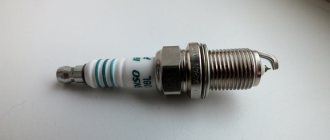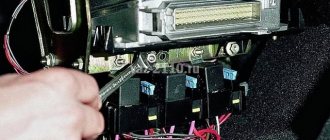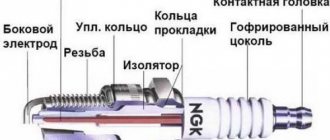Glad to welcome you again, friends! In our country, everyone knows that if a man drives a domestic classic, then he knows the mechanics exactly, and no breakdowns matter! It doesn't matter if the car drives or won't start, we will find the reason and repair the car!
Let’s simulate a situation: on a frosty winter day it’s early morning, and the temperature outside is 20 degrees below zero or even higher. When you finally opened the frozen door and sat down in the cabin, you realized that the car would not start. While you are pondering the possible cause, an experienced person will remember how to light the spark plugs in your home since the cause is obvious. If you were a driver from the USSR, you would probably have time to work, but the chance not to be late is also yours! Don't miss out, read on!
Causes of malfunctions
Spark plugs and malfunctions are associated with the appearance of:
- Wear, usually of the side electrode.
- Crack in the insulator body.
- Melting of both electrodes.
- Erosion – thinning of the side element.
- Carbon deposits.
Wear
Failure to replace spark plugs in a timely manner leads to distortion of the gap and, as a result, sparking with the consequences of poor starting of the car. Wear of the side electrode is caused by additives contained in gasoline. The result is missed sparks and engine detonation. Products are subject to replacement.
Cracked spark plug body and insulator
Even unnoticeable cracks or visually visible chips or chips on the body of the insulator are considered reasons for replacement.
When using spark plugs with cracks, current leaks through the insulator to the spark plug body
Defects appear as a result of:
- wear and tear (natural).
- Detonation due to early ignition angle.
- Low octane fuels.
- Low quality insulator.
- Incorrectly set gap.
A defective spark plug insulator causes current leakage. This fact leads to a decrease in the spark discharge between the electrodes. And this is already a difficult engine start, low throttle response, jolts when moving from a stop, unstable idle speed.
Reflow
Melting of electrodes is a manifestation of serious overheating
The appearance of rough, porous soot. Occurs due to thermal load, low octane gasoline, early ignition cycle. Defects in the distributor (distributor) or valves cannot be excluded. Mixture formation and ignition are checked, spark plugs are changed.
Erosion
Signs of erosion appear on the electrodes of spark plugs that have exhausted their service life.
Caused by oxidation and incorrect gap setting. Erosion will dominate the interaction of lead in gasoline. This presence creates a chemical reaction with, for example, nickel electrode material.
Layering
A pronounced brown-yellow, thick layer of plaque is evidence of the presence of additives (ethyl) in the fuel.
Being a current conductor, carbon deposits lead to distortion of spark formation (at high loads). Since it is useless to remove such deposits, there is a need for replacement.
Car requirements
If a vehicle has scored less than 100 penalty points, then it is recognized as a classic vehicle, and the new GOST will be applied to it. If you deviate from the original, points are deducted; if they are consistent, they will be awarded. If a car owner has scored 120 penalty points, then if a major criticism is eliminated by 25-30 points, he will undergo an examination. After passing such an examination and receiving less than 100 points, the car can become a full-fledged participant in road traffic.
The requirements for vintage cars are simpler, and they will be dealt with by their own experts. Replacing the engine would be a serious violation. But if the car owner returns the previous unit to its place, then he can undergo an examination and receive a passport for a classic vehicle.
Of great importance in determining the requirements is Section 7 of the said GOST “Technical requirements for classic vehicles for permission to drive on public roads and verification methods”: it specifies the requirements for the car’s brakes, steering, wheels, lighting, etc. Classic status vehicle for a car that has accumulated less than 100 penalty points is issued for a period of up to 5 years
Classic vehicle status for a car that has accumulated less than 100 penalty points is issued for up to 5 years.
BMW 5 series #Jet frog# › Logbook › Calcination of spark plugs!
Since I have two sets of candles now. Some are standing in the car, while others are just lying around. I decided to bake them at home. I laid them out on the tile and left them to bake for about 40 minutes. Of course, the house smelled quite a bit of oil, periodically I twirled them like a kebab so that they would get burned on all sides, then once they were heated, we waited for them to cool down and wiped them off. I won’t install them yet, but let them be in stock. The result of calcination can be seen in the photo!
And don’t forget about safety measures, the candles are hot!
Well, a little theory about how you can clean candles:
Physical cleaning of spark plugs
Manual cleaning of spark plugs
- one of the popular cleaning methods. In this case, remember that the insulator is very easy to damage or scratch. This should not be allowed, otherwise carbon formation on the scratched insulator cone will accelerate and intensify. Therefore, cleaning spark plugs with sandpaper and other hard materials is not allowed. A suitable tool for restoring spark plugs is a thin steel wire brush, a hard hair or nylon brush, or a toothbrush.
Cleaning spark plugs with a sandblasting machine/installation
- a method that is used at many service stations. Removal of spark plug deposits and other contaminants is carried out using different types of sand and blowing with compressed air. It is believed that this is one of the effective methods that allows you to return a second life to a spark plug. For a low price
Cleaning candles with sand at home.
With sufficient skill and the presence of a drill with reverse, this method is not much different from “sandblasting”.
Thermal effect on spark plugs
Another way is to burn candles. It is usually used if almost new spark plugs were filled during a cold start. It’s a shame to throw them away, so they resort to drying the candles. There are different ways to dry candles, and everyone shares their own methods:
Heat the candles with a torch or blowtorch (without fanaticism, they’re dry and that’s enough), and then lightly clean the electrodes and insulator with a copper brush.
Heat the candles on a gas stove.
This must be done until the threaded part and the side electrode turn red.
Chemical cleaning of spark plugs
This method allows you to remove carbon deposits on spark plugs using chemicals. Anything can be used as cleaning agents: fairy, carburetor cleaner, rust remover, acetone, vinegar, Sprite and Coca-Cola.
Cleaning spark plugs with rust remover
Apply a layer of 2-3mm, after waiting for 30-60 minutes, clean the candles with a wooden stick and rinse in water. Acetone is used in the same way.
Cleaning candles with silit.
Fill the candles with silit and place the jar under pressure of hot water. We observe the chemical process for about an hour, and then clean the surface of the candle with a toothbrush.
Cleaning candles with Coca-Cola.
Phosphoric acid, which is found in some drinks (7up, Sprite and Coca-Cola), is said to be effective in removing carbon deposits from spark plugs.
Cleaning candles with vinegar.
This is the old “grandfather’s” method, when candles are soaked in acetic acid for an hour. Then add 5 drops of electrolyte and clean with a toothpick.
Cleaning spark plugs with ammonium acetate.
First, the spark plugs are degreased by washing them in gasoline. Then dry, and then immerse them in a hot 20% aqueous solution of ammonium acetate (ammonium acetate). Keep in it for 25–30 minutes. at a temperature not lower than 90C (possible with a low boiling solution). This cleaning should be done in a well-ventilated area; acetic acid fumes are poisonous. Then the spark plugs are cleaned with a nylon brush.
Cleaning candles with ultrasound combines both chemistry and sound.
This method is used to clean injectors, but some service stations also clean spark plugs in this way. They say there is an effect, but not as good as from “sandblasting”.
Cleaning spark plugs in phosphoric acid with heating.
The idea is to dip the candle in acid, then heat it with a lighter for about 50 seconds. The acid will boil and turn dark brown. Then place the candle in acid again and heat it again. And so five times with each candle.
And finally, bonus! How to properly ignite candles, this is the most effective option!
https://youtube.com/watch?v=UfkaSqJlqjs
Auto parts and service stations
Many owners of vehicles, especially those belonging to the domestic automobile industry, often experience in winter that the spark plugs turn black or acquire a dark tint.
In this case, a logical question arises: what needs to be done to solve the problem? The answer in this case is simple - clean the components. It is worth noting that cleaning can be done on your own. Let's try to figure out how to clean spark plugs from carbon deposits. In addition, this material will discuss the reasons for this situation. Features of cleaning spark plugs at home
Cleaning spark plugs at home is a fairly common cleaning method. In this situation, it is necessary to remember that the insulator included in the structure can simply be damaged or scratched by careless movement . Of course, allowing such a situation to arise is highly discouraged. Otherwise, problems with the formation of carbon deposits on the surface will worsen. That is why the cleaning process using sandpaper or any other devices is unacceptable. The ideal option as a tool for restoring the structure of candles is to use a brush. However, it must be made of steel wire. A regular toothbrush may also work.
Speaking about how to clean spark plugs from carbon deposits, we cannot help but talk about the use of sandblasting equipment. It should be noted that this method of cleaning is widely used at many vehicle service stations. The process of removing carbon deposits from the surface is carried out through the use of various types of sand, as well as the use of blowing through compressed air. It is generally accepted that this method is one of the most effective and allows you to return the component to normal, working condition. At a very reasonable price, this method allows you to restore the part as quickly as possible.
When talking about how to clean spark plugs, we cannot fail to mention sand. Thus, a separate category of “craftsmen” inserted the part into the chuck of an electric drill and turned it on, having previously placed it in a container with sand. Of course, the method may seem very strange. Moreover, this method of cleaning spark plugs from carbon deposits is effective. Having certain qualifications and experience in this matter, the method will not differ from where sandblasting equipment is used.
How to clean spark plugs at home using heat
If you are thinking about how to clean spark plugs from carbon deposits, then you can use a fairly common method that involves thermal exposure. This option involves burning the component. As a rule, this method is used if new spark plugs were filled during a “cold” start. It’s a pity to throw away such components and, as a result, people decide to carry out the drying process. It should be noted that in this case there are several main methods. Among them are:
- Calcination using a soldering iron.
- Calcination using a gas-type stove.
The method is not particularly complicated. At the same time, car owners who have used it recommend not calcining the spark plugs too much.
Chemical cleaning method
It is also possible to revive spark plugs using chemical-based products. This method allows you to remove carbon deposits from these components as quickly and without problems as possible. In order to perform this procedure, you should buy a simple detergent or liquid that is designed to clean carburetors. You can also clean spark plugs with vinegar.
A cleaning procedure using a rust remover is also permitted. To use this method, you need to unscrew the part and apply a layer of several millimeters to their surface. Next, you need to wait half an hour and clean the surface by rinsing with water. It may seem very funny, but the cleaning process is also carried out with the help of Coca-Cola. There are rumors that orthophosphoric acid, which is included in many drinks, can most effectively cope with the carbon deposits that have appeared on these components.
Speaking about cleaning with vinegar, first of all it should be said that this method is quite old. In this case, it is necessary to place the candles in a container where vinegar has previously been poured. The components must be kept in this container for one hour.
You can also clean spark plugs at home using ammonium acetate . Initially, candles must be subjected to a degreasing procedure. Next, they need to be washed using gasoline fuel. At the final stage of this type of procedure, the drying process is carried out. It is necessary to immerse the candles in a 20% acetate solution. They should stay in it for about thirty minutes. In this case, the temperature should be at least 90 degrees. When carrying out the cleaning process, you must make sure that the room is well ventilated. The fact is that the fumes emitted by acetic acid negatively affect the human body due to the fact that they are poisonous.
It should be noted that spark plug restoration can be carried out in other ways. At the same time, a fairly large number of them are difficult to implement. That is why their use is recommended for those people who have work experience.
How to check spark plug operation
Of course, as soon as cleaning the spark plugs with your own hands has been done, it is necessary to carry out a procedure that involves checking their functionality. It should be noted that in this case you need to install the components back and try to start the car engine. If you understand how to properly clean spark plugs, then there will be no problems with this procedure. Please note that the car should function without any problems.
How to Restore Spark Plugs Reliably
Situations when a person does not have the opportunity to independently perform work of this type are not so rare. That is why if you are not sure of the correctness of performing the procedure yourself, it is recommended to contact specialists who are competent in this matter. It is worth saying that they will not only be able to tell you how to perform the procedure for cleaning spark plugs, but will also help you complete this work. Note that this approach provides an additional guarantee that after cleaning from carbon deposits, the parts will remain operational.
If, after performing the cleaning procedure, the problem has not been solved, then the only way out of this situation is to purchase new parts that need to be installed. You can do this yourself. Also, the procedure will take no more than a few minutes in a specialized service center. In general, you need to understand that if the spark plugs have been subjected to a restoration procedure, sooner or later they will need to be replaced.
Conclusion
If all vehicle systems are functioning correctly and the quality of the fuel used is high, then the spark plugs need to be cleaned. As soon as their operational period is completed, they must be replaced with new ones. At the end of the operational period, proper cleaning of the spark plugs will no longer help solve the problem.
the candles were flooded during cold weather , then the only correct way to solve the situation is also to clean the component. You do not need to remove the part to do this. It is enough to start the vehicle engine and let the engine run at sufficiently high speeds. By approaching the issue of servicing your car correctly, you will not have any significant problems with it.
Cleaning spark plugs at home is a fairly common cleaning method, but you need to be careful not to damage the insulator.
How not to clean spark plugs: don't be fooled by nonsense!
Regular readers know that the vast majority of articles on this resource are honest copy-paste of each other. And so, once again scrolling through the feed, I came across a note from one “top” autoblogger about cleaning spark plugs. Or maybe not just one - I repeat, the guys stupidly “lick” each other’s articles, sometimes even practically without changing the title. And I, as a person writing exclusively from the perspective of my own (very rich) practical experience, and not mindlessly rewriting jaundiced Internet notes, I really want to warn you
.
A widely known method of chemical
cleaning the electrodes and the lower surface of the insulator of spark plugs with high mileage. It consists of placing the lower part of the part in a jar with a rust converter, a cleaner for cooking stoves and other powerful compounds. And then, after a couple of hours, you take out the spark plug, wipe it with a cloth - and beauty! Like new. And everything would be fine, but...
How does carbon deposits come off the spark plug electrodes?
Due to the acid, my friends. And those who have already conducted various kinds of experiments know very well - neither solvent, nor kerosene, nor other nephras ( petroleum solvent
) this soot is not taken at all. Why? Right. There's no acid there. It is this that neutralizes all the blackness that has accumulated on the spark plug over months and years.
In general, are you sure that the candle itself is to blame for this. But if everything is much more decent with you, then why clean anything at all?
The carbon deposits are gone, the spark plug is clean - profit.
Nope. Although it has become clean, strictly speaking, you have ruined it. The fact is that the central electrode has long been covered with a thin layer of alloying compounds: yttrium, iridium and other fancy words. For what? Since this element is the most thermally loaded
(approximately 600-800 degrees operating temperature). And it is this kind of spraying that is designed to partially protect the electrode from melting, and at the same time minimize the effect of “sticking” of combustion products to the metal. Very rough, it can be compared to the Teflon coating on frying pans.
So, under the influence of acid, this microlayer comes off along with carbon deposits. After which the electrode loses its original properties
. A given heat resistance, the ability to form an electric arc in a calculated manner and that very carbon deposits that you were fighting against.
Even in citric acid it sizzles beautifully, the dirt falls off wonderfully, but... But the actual performance characteristics after such a procedure only became worse.
How to clean correctly?
Yes, strictly speaking, no way. Well, this is not a part to bother with servicing. On a working modern engine, spark plugs can easily last 60 thousand kilometers or more (as intended). These are not words of advertising, this is, again, personal practice. And if at every oil change you unscrew the spark plugs and see that they are all coated with dirt and carbon deposits, then this is a reason to think about the condition of your car’s engine, and not about how bad the spark plugs are and how to clean them as quickly as possible.
But if it really itches, then you can clean it. But it’s long and tedious (but without damaging the details). This is the old-fashioned method of heating over a stove with periodic back-and-forth movements with a stiff toothbrush. It takes a long time, is ineffective, and you cannot achieve beautiful “factory” cleanliness, as is the case with acid. But it is relatively safe for the spark plug itself. But whether such a game is worth your candle is up to you to decide.
Cleaning spark plugs with harsh abrasive treatment is especially prohibited.
I hope it will be useful to someone!
Clean spark plugs and less bad advice to everyone!
German "Meriva"
Each car has a spark plug tightening torque indicated in its passport data. Opel Meriva uses a spark from a gap of 1.1 mm. Replacement is made with a 16 mm wrench. To gain access, remove the plastic cover, remove the connectors and unscrew the 2 bolts.
The first step is to remove the coil block along with the spark plugs. Carry out an external inspection for the presence of soot and chips. To tighten it, it is better to use a spark plug wrench with a rubber insert. You will also need sprockets for dismantling decorative elements in the engine compartment. For installation, reverse manipulations are carried out, the tightening torque is 25 Nm.
The spark plugs must be crimped with a certain force to the gasket thickness specified by the manufacturer. Ideally, it should be equal to 1.7 mm. But inexperienced repairmen manually turn it up to 1.2 mm, when the risk of damaging the ceramic inserts increases.
Conical spark plugs are more fragile and require torques with a low error of ±2 Nm. Therefore, it is better to buy an original torque wrench. Cheap tools are usually disposable. Good spark plugs also cost a lot compared to the cost of a key.
How to ignite a spark plug?
One day, in the cold winter... The car suddenly wouldn't start... Perhaps this is how we can start the story about how drivers often face the problem of starting the engine in cold weather, when the thermometer needle outside the window drops below -20 degrees. The reason for this may be ordinary spark plugs, which were filled with gasoline and automatically left without a spark. To solve this problem, you just need to learn how to calcinate spark plugs, doing it correctly and without much effort.
Actually, the reason for the lack of spark is quite banal. The candle is gradually filled with gasoline entering the combustion chamber, thereby making it so wet that there can be no talk of any sparking, since there is no discharge between the electrodes. And since there is no spark discharge, then there is no ignition, which is necessary to start (start) the engine. But first, it’s still worth understanding that this is precisely the problem.
Troubleshooting
To understand whether they are filled with gasoline or not, whether there is carbon deposits on them or not, you need to do a small and very simple procedure. To do this, prepare only two tools: a special spark plug wrench and pliers.
- Turn on the ignition and unscrew the spark plugs. All modern cars typically come with one per cylinder, meaning there are exactly as many of them as there are cylinders in your car's engine.
- Disconnect the unscrewed spark plug from the wires and unscrew one after the other.
- Inspect them all for moisture, carbon deposits and a strong smell of gasoline. If everything listed is present on them, then they need to either be replaced with new ones or cleaned by calcination, which is what we are going to do.
Calcination on fire
Having removed the gasoline-filled candles, the simplest action would be to calcinate them on the open fire of any gas stove.
It’s really simple and convenient if you grab each one with pliers and hold it over the flame for a while until the smoke stops emanating from the burning of the gasoline that got there. Therefore, if the car is located near the house, and gas is used at home, then run home to heat the stove on the fire. If the car is parked far from the apartment (house), then you need to keep, for example, an ordinary alcohol burner in the garage, on the flame of which you can ignite candles in the same way. Of course, you can get an open fire, so necessary for calcination, in any other way, but you should be extremely careful with such things in garages or parking lots. There is no question of fires, but no one bothers you to soak some rags in gasoline and step aside to set them on fire.
After wetting, quickly leave the dangerous area and set fire to these rags, and then in the same way, holding one piece at a time with pliers, heat them over the flame. Under no circumstances should you artificially cool a candle. The fact is that its porcelain part, although made of durable and fire-resistant material (porcelain), may still not withstand sudden temperature changes and will easily crack, becoming unusable. This means that after calcination, you simply leave it alone for 10-15 minutes until it cools down naturally.
The final stage or return to its rightful place
After completing the calcination and allowing the candles to cool on their own, take an absolutely clean and dry rag (rags) and thoroughly wipe each one separately. Do this with effort, cleaning from the soot, which could quite possibly appear during ignition, until the porcelain is perfectly white. Return to your car and safely screw in each spark plug in order, not forgetting to put the wires on them. Remember that the further starting of the car depends on the accurate fastening of the spark plugs.
If the spark plugs are placed, secured and connected correctly, and there are absolutely no other engine problems, your car will start immediately and easily.
Advice for the future
In order not to find yourself in a similar situation, not to run home every time, not to do nonsense, not to hold it all over an open fire for 10 minutes and not wait for subsequent cooling, wiping and screwing, do not be lazy and do not skimp. Find out the brand of your spark plugs (it is written on their body), visit any auto store and buy yourself a spare set, then there will be no need for the above actions.
https://youtube.com/watch?v=UfkaSqJlqjs
Conclusion
No matter how effective your method of burning plugs is, it is important to understand that this is an extreme measure; it is better not to get into such a situation. I advise you to purchase spare ones in advance! Marking the plugs is what will help you buy a truly suitable model, knowing the code of the standard plugs for your car, an analogue can be picked up without any problems in any automobile store. I am very glad that you finally know how to light spark plugs correctly and efficiently! I am sure that such knowledge will be useful to you, then you will remember me). See you in the next publications .
How to unscrew a broken spark plug?
The spark plug is a delicate element of a car's engine starting system.
Careless movement or excessive physical force when unscrewing the spark plug can lead to its breakage. The lower threaded part will remain in the cylinder head and you will have to tinker a little to remove the broken part
In principle, there is nothing complicated and after spending a certain amount of time you can unscrew a broken spark plug.
Most often, breakdown of the spark element occurs when trying to replace it or clean it from soot and carbon deposits.
Excessive force of the spark plug wrench or careless movement leads to damage to the integrity of the spark plug.
In order to unscrew a broken spark plug, proceed as follows:
Turn off the vehicle engine.
It is strictly forbidden to carry out work while the engine is running. There is a risk of electric shock or damage from rotating motor parts.
Wait for the engine to cool down.
The operation of a car engine causes an increase in the temperature of its main working elements. When performing steps to remove a broken candle, you can get a burn on your hand. There is one more rational grain in engine cooling. As you know, when heated, metal parts increase in size. Removing a broken spark plug on a hot engine in this state becomes simply unrealistic.
Clean the work area.
A special cleaning fluid can be used to clean the work area around the broken spark plug element. It perfectly dissolves carbon deposits and soot. Using an ordinary car compressor, it is recommended to blow out the spark plug well with compressed air.
To perform the following steps to remove a broken candle you will need:
-lubricating fluid WD-40 or Vedeshka. Its use will lubricate the threads of a broken spark plug and thereby facilitate the unscrewing process.
-extractor. A special wrench for unscrewing broken elements from hard-to-reach places. Despite the tricky name, it is a very convenient thing and is popular among car repair professionals.
- torque wrench. A special key that allows you to control the force aimed at unscrewing or tightening the element. Its use will make it possible to rationally use physical force and prevent the final failure of the thread of a broken element.
- unscrewing a broken spark plug
Vedeshka is used abundantly. The extractor is screwed into the broken spark plug. A torque wrench is used to control the force and prevent thread stripping. There is no need to rush and all actions should be as smooth and careful as possible.
If you feel that the thread will break, you must stop active actions and add lubricant. There is no need to act through force, as you can break the thread and thereby “get money.” Drilling out a spark plug is a costly procedure and carries a risk of engine damage.
After removing the spark plug fragment, you need to carefully inspect the spark plug well for the presence of remnants of the broken element. You can use an ordinary carrying lamp or a flashlight. The thread should not have obvious damage, otherwise problems may arise with screwing in the new spark plug.
In principle, at this point the actions of unscrewing the broken spark plug can be considered successfully completed.
Self-cleaning of SZ
There are quite a few ways to perform high-quality cleaning of spark plugs in a garage and completely restore all the working qualities of the elements.
Physical
Quite often, motorists resort to simple mechanical cleaning using sandpaper (zero) or a stiff brush. The spark plugs are removed and the electrodes are simply mechanically cleaned. But this method is only permissible if urgent cleaning is required, for example, on the road. In all other cases, such cleaning will do more harm. Hard materials leave scratches on the spark plugs, which will cause carbon deposits to settle on them more quickly. When cleaning the electrodes in this way, the protective coating can be damaged, and the spark will stop striking in the right place. This is especially true for iridium ignition elements.
Sandblasting
This method can only be used in a car service center, or provided that the motorist has such a device in his garage. The “sandblast” itself, of course, can be bought, but its cost is approximately 6 thousand, and many motorists would prefer to simply buy a new set of ignition elements. True, there are craftsmen who can assemble a sandblasting machine themselves. The device operates using compressed air and a small amount of sand. A dirty candle is inserted into a special hole and air and sand are supplied under high pressure. It is advisable to rotate the candle, and the sand will be able to remove almost any deposits. If necessary, before starting cleaning, it is recommended to bend the electrodes a little and after completing the procedure, adjust the broken gap.
Thermal
If for some reason the candles have been flooded, then it would be most advisable to use the thermal method to clean them. It involves drying the elements using fire. This can be done using a gas torch, blowtorch or on a gas stove. Heat the candle until red and then use a soft copper brush to remove any remaining carbon deposits.
Chemical
The most common and, perhaps, the most effective method of cleaning SZ is the method using chemicals. Before any chemical cleaning method, candles should be thoroughly degreased, which will allow the chemically active substances to start working faster. For this purpose you can use:
Household chemicals. These can be products for removing rust and lime deposits. Some people recommend using vinegar or acetone. A good effect can be observed when using simple Silit. The candles are placed in the selected solution for about half an hour. Then they are further cleaned using an old toothbrush or a hard paint brush. After finishing cleaning, the SZ should be rinsed as thoroughly as possible with clean water. Next they are wiped with a cloth and dried well. "Coca-Cola", "Sprite" or "Fanta". These drinks contain phosphoric acid, which can also make it easier to remove carbon deposits. The cleaning procedure is similar to the previous option. Ammonium acetate 20%. Candles are placed in this solution and heated to approximately 90 degrees. Then the candles are cleaned with a brush, washed and dried.
It is worth noting that the use of this cleaning option requires a well-ventilated area, otherwise this procedure can be harmful to health.
Ultrasonic
This procedure is most often possible only in a car service center. SZ are placed in a special liquid, and ultrasound is directed at them. The cleaning result is usually very good, but, unfortunately, quite expensive - sometimes it’s easier to buy a new set of car spark plugs.
Home chemistry laboratory
Separately, I would like to consider several products that have shown themselves to be good. They really make it possible to quickly and effectively rid spark plugs of accumulated carbon deposits.
You just need to work with them extremely carefully, observing safety precautions.
- dimexide;
- acetic acid with soda;
- hydroperit.
Now let's go through them separately.
In practice, chemical cleaning gives almost the best result possible for doing it at home. Yes, it is optimal to contact a specialized service, where they will clean the spark plugs on a special stand or even on an ultrasonic unit. The last option is the most effective, but also the most expensive. Therefore, only those who are willing to spend that kind of money on restoring several worn-out spark plugs of an automobile ignition system resort to it.
It is worth recalling that malfunctions and clogged spark plugs can lead to a number of consequences. These are situations when the car starts and immediately stalls, or so-called engine detonation occurs. Even if your car just simply won’t start, the spark plugs are one of the first to be checked.
Use of dimexide
Dimexide is able to cope with light and complex types of spark plug contamination. Even if the soot is serious, there is a high probability that the situation will be corrected with dimexide.
Dimexide is a pharmaceutical product intended primarily for treating the skin on the face. But in fact, the composition can corrode many components, including carbon deposits and scale. Using the product is extremely simple. You need to take a small plastic cup, pour 50 ml of the product into it, put it inside the candle and leave for several hours. After which the candles are taken out and cleaned with a simple toothbrush. All that remains is to rinse with clean water and dry.
Efficient, effective and quite simple. I recommend trying it.
Acetic acid and soda
Here you need to use acid (70%) and not table vinegar, since the effectiveness of the latter is extremely low.
The essence is approximately the same as in the previous version. You need to pour a small amount of acetic acid into the candles and leave for at least 30 minutes. But you shouldn’t keep it for more than 3 hours.
When the candles are infused in acid, gradually add literally 1 teaspoon of soda. A chemical reaction will begin. After this, take a toothbrush, treat the candles, rinse and dry.
Hydroperite
This product is sold in pharmacies, presented in tablet form.
Now take a glass. Better made of glass. Fill up to half of the water so that the candles are well immersed. Place 3-4 tablets of hydroperite into this water. Cleaning with hydroperite will occur gradually. Place the glass on a window or in a warm place. You can safely leave it for about a day. Only after a while will an active reaction begin in the form of seething and boiling.
Take out the spark plugs, go over them with a brush or blow with compressed air. Dry and return to place. Check the remanufactured spark plugs for functionality.
Always keep a set of spare spark plugs with you. It’s not for nothing that they are included in a motorist’s kit, even if it’s not mandatory.
What effective remedies do you know? What did you have to deal with personally and what was the result?
Subscribe, leave comments, ask questions and tell your friends about our project!
(
2 ratings, average: 5.00 out of 5)
How to change it yourself?
Replacing spark plugs is one of the simplest procedures in the list of engine maintenance work. To complete it, you will need not only theoretical knowledge, but also tools:
- torque wrench. Is it possible to replace spark plugs using a regular wrench? It is possible, but only if you have already changed the spark plugs 10-20 times before using a torque wrench and can trust your muscle memory. Of course, you won’t have such a wealth of replacement experience. From the article you will learn what disastrous consequences lead to under-pressed or pinched candles;
- spark plug head. It is longer than a conventional socket head, since a margin is needed to fit inside the insulator and the contact tip of the spark plug. Some types of heads have a built-in magnet or a retainer, which, when replaced, makes it easy to remove the spark plug from a deep well.
- extension. Necessary for replacing spark plugs on cars with deep spark plug wells. Also, with this type of design, it is highly desirable to have a compressor and a blow gun. Before replacing spark plugs, it is recommended to blow out the spark plug wells to prevent dirt from entering the engine cylinders;
- a wrench or spark plug wrench used to unscrew old spark plugs.
The list of tools will vary depending on the number and type of fastening parts that will have to be removed before unscrewing the spark plugs. You can find exact information on this matter in the repair and operating manual.
Sequencing
The instructions are based on the example of Daewoo Matiz.
- Wait until the engine cools down completely. It is necessary to unscrew a spark plug with a metal threaded part from an aluminum cylinder head. Due to the difference in thermal expansion coefficients when the motor heats up, the threads may bite.
- Remove the high voltage wires. To avoid damaging the GDP, when removing, pull on the lugs, and not on the wires themselves.
- Blow out the spark plug wells. The entry of debris into the combustion chambers is fraught with the formation of scuffing on the surface of the cylinders, which will significantly accelerate the wear of the CPG. It is also possible for dirt particles to stick to the places where the valve plate chamfer is pressed against the cylinder head seats. As a result, the engine will begin to sputter, vibration will appear, popping noises will appear in the intake or exhaust manifold, dynamics will deteriorate and fuel consumption will increase. Due to loose pressure of the plate to the seat, heat dissipation deteriorates, which during long-term operation of the engine can lead to valve burnout.
- Remove the old spark plugs. If the car will be parked on the street for a long time, or repair work is still to be done in the engine compartment, the spark plug wells must be covered with pieces of clean rags.
- Screw in the new spark plugs by hand or using just a socket and extension. You should feel that the twist is proceeding without distortion. Using a torque wrench, create a tightening force of 30 N*m (the manufacturer recommended a force of 25 N*m for the Daewoo Matiz engine, but a slight increase in the tightening force is acceptable).
- Install the high-voltage wires (make sure that the tip of the GDP is tightly fixed to the contact tip of the spark plug).
Check the gap
You should not blindly trust the manufacturer. Before replacement, check the gap between the side electrode and the center electrode by comparing it with the reference value for your engine model. An incorrect air gap will worsen the ignition of the fuel mixture, which will lead to loss of dynamics and increased fuel consumption.
To check, you need not only to know what the gap should be on car spark plugs, but also to have a set of dipsticks.
What gap should I set on spark plugs for gas and gasoline?
Often, after installing gas equipment on a car, the internal combustion engine begins to throttle, failures appear and gas consumption is higher than expected. These phenomena can occur for various reasons, one of the options is misfires due to an increased gap in the standard spark plugs, due to burning of the electrodes when operating on gasoline. Moreover, when switching to gasoline, everything returns to normal. The problem is solved by reducing the distance between the electrodes or replacing the elements.
A correctly adjusted spark plug gap for gas combustion directly affects the completeness of combustion, the efficiency of ignition of the fuel mixture and the stable operation of the engine, so for gas the size is set in the range of 0.7-0.9 mm. But this parameter is very individual and is selected depending on a number of factors:
- type of ignition system used;
- engine model and characteristics;
- conditions and mode of operation of a car with gas equipment.
For more frequent driving on the gas mixture, gaps of 0.7 mm are suitable and vice versa.
All existing methods
So, what would be the first actions of an ordinary Soviet driver in such a situation? In fact, calcining spark plugs is a whole complex of absolutely not complicated, but still actions. First of all, you need to establish which spark plug is at fault; to do this, you will have to unscrew all four and inspect them for moisture, carbon deposits and octane aroma.
The heating value of spark plugs can be increased only by “general cleaning” on the electrodes. You need to clean the device as much as possible, but simply “wiping dust” will not be enough! Believe me, gasoline and carbon deposits are not so easy to remove without special preparation!
Although, on the other hand, you can’t guess here: sometimes ordinary scraping with a knife can help, and sometimes calcination turns out to be useless.
From my own experience I can say that in the absence of a spare set of spark plugs, this is the only option to make the car drive again.
Calcination by fire
Most often, drivers resort to the method of hot cleaning the spark plug. To do this, you need to burn the part by any means; forgetting about safety is not recommended! The procedure itself looks simpler, simpler: grab the candle with pliers and hold it on the flame until the gasoline stops burning out.
Note: calcination ends the moment the candle stops emitting smoke.
As for the source of fire, it could be anything! While at home, for example, you can do everything in the kitchen on gas, of course, while your spouse is not looking). If this is not an option for you, I recommend using a regular gasoline burner; you will agree that it is a necessary thing in any garage! When “trouble” takes you by surprise on the road, you need to use your wits. Light a fire, a rag soaked in gasoline, or even a candle!
Many car enthusiasts often do not know how to properly complete calcination. Is it possible to artificially cool an iridium or any other spark plug? As a result, instead of resurrecting the candle, they finish it off. Without a doubt, porcelain is a durable material, in our case even fire-resistant, but it does not tolerate temperature changes very well and can easily crack. Take your time, leave the parts for 10-15 minutes and they will cool naturally!
When you have succeeded in heating the candles, do not rush to put them in place! Wipe each candle thoroughly, using a knife if necessary. And only after that you can screw them back in, put on the caps of the wires and finally start the car! Now you have definitely managed to raise the heat value of the spark plugs, a table of these values is available, available here.
other methods
No matter how good it is to heat spark plugs with fire, you need to keep in mind that this is not the only effective method. Let's briefly consider all the currently known options.
- Cleaning with a sandblasting machine is the most effective method of all existing ones; of course, calcination at home will not work, only at a service station, by the way, the price is tolerable!
- Manual sand cleaning - some people still manage to achieve the sandblasting effect in their garage, but this will require good skill in working with a drill in reverse.
- Chemical cleaning - use anything, rust remover, Silit, Fairy, vinegar, acetone, phosphoric acid and even Coca-Cola or Sprite.
- Ultrasonic cleaning - this method is used mainly to clean injectors, and sometimes also spark plugs.
Top 5 ways to cleanse yourself at home
Many drivers clean spark plugs at home using different methods and means. This is done in order not to contact auto repair shops. Service workers inflate prices for services. To save money, it is recommended to clean the electrodes yourself.
Using household chemicals
Household chemicals are used when you want to clean candles quickly and safely. Many people are interested in whether it is possible to use VD 40? Yes, it is allowed to pour the product into parts for pre-soaking. It doesn't handle carbon deposits well.
What other chemicals can be used against soot:
soda (containing phosphoric acid);
acetone;
Fairy - dishwashing gel;
any store-bought plumbing chemicals.
To effectively clean spark plugs, you need to take rust and limescale removers. After soaking, the parts are treated with a toothbrush. The result depends on the type of product and manufacturer. After the procedure, the candles are washed with warm water and dried. Under no circumstances should you install wet candles or dry them in an oven (microwave).
Sandpaper
Sandpaper temporarily improves the appearance of the electrodes. But we cannot say with complete confidence that this is the best cleaning method. Processing with fine-grained paper will leave small scratches on the candles, which will attract carbon deposits faster. Why is this happening? The fact is that gasoline gets into the microcracks. He doesn't have time to evaporate. The carbon deposits “stick” to the surface more strongly. This method is used when replacement of candles is required, but it is not yet possible to carry out the procedure. It is prohibited to use sharp objects and tools instead of sandpaper.
Ammonium acetate
The use of ammonium acetate entails strong cleaning
The liquid is unsafe for human health, so you need to work with it with caution. For the procedure you will need 20% ammonium and a brush with high bristles.
Algorithm for performing the procedure:
The candles are placed in a container with gasoline and then washed in it.
Ammonium is poured into a steel bowl.
The liquid is heated over a fire. You can bring it to a boil.
After the ammonium boils, candles are placed in it.
The parts are soaked for 20-40 minutes, after which they are cleaned with a brush.
The candles are washed and dried.
The procedure is performed in a well-ventilated room. During boiling, ammonium evaporates, releasing toxic substances. Therefore, it is worth putting on a mask, opening windows and doors.
If these spark plugs are not installed directly into the car, then they need to be treated with VD 40. Ammonium acetate is a strong agent that destroys the protective layer on metal areas. Without treatment, rust will appear on the surface over time.
Instead of ammonium, it is allowed to use acetic acid (70%). After soaking, add a couple of teaspoons of baking soda to start the reaction. After this, the candles are brushed, washed and dried. This method is more gentle and safe. Technical vinegar does not wash away the coating from the surface.
4.Thermal method
The thermal method, or calcination in other words, is an effective, affordable and safe method of cleaning. Its essence is to heat the candles with a soldering iron, over a burner, or on a gas stove burner.
Most often, this method is used when new spark plugs were accidentally filled during a cold start. There is no point in throwing parts in the trash. It is enough to place them on the fire until the red color appears. The carbon deposits come off almost instantly. The candle does not overheat thanks to the ceramic insulator.
5.Cleaning by hand using drill and sand
In most cases, not every home has a sandblasting machine. But the car owner can build it with his own hands. To do this, he will need a drill with reverse and sand. The candle is placed in the tool socket and begins to rotate, having previously been dipped into a container with sand. The procedure is repeated until the electrode is completely clean.
Instead of sand, you can use a wide brush with steel wires. As a last resort, when there is neither sand nor a brush at home, take any abrasive powder. All spark plugs, except iridium ones, can be treated in this way.
Owners of powerful cars prefer to buy iridium spark plugs. The products have a high melting point and increased wear resistance. It is not recommended to clean such parts yourself.
Household chemicals
If you want to clean your spark plugs yourself, but prefer safer methods that are just as effective, try simple household chemicals.
Regarding the question of whether VD40 can be used to clean spark plugs, I will say this. It will help as an aid for pre-soaking. But it doesn’t work well as a stand-alone carbon deposit cleaner. It is better to use other methods.
As for household chemicals, products designed to remove rust or limescale work well. In fact, this is any product aimed at cleaning and cleaning plumbing fixtures. You just need to soak the candles in this product for a while, and then carefully brush them with a toothbrush. The result depends on many components, including the components used in household chemicals. When finished, be sure to rinse the candles with clean water and dry completely.
It is difficult to say exactly what the result will be. Therefore, I suggest leaving reviews for those who have tried different household products and can speak from personal experience about their effectiveness.











